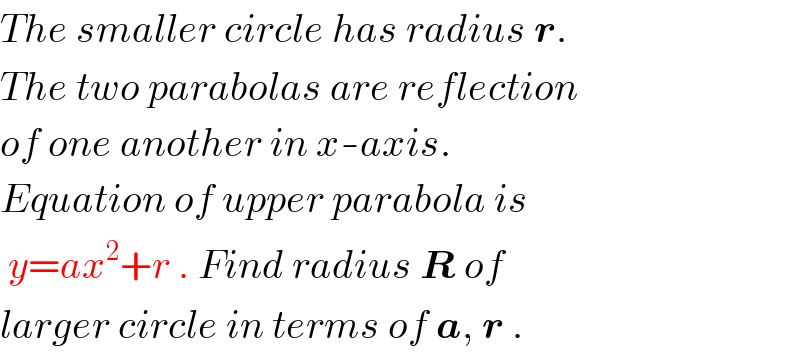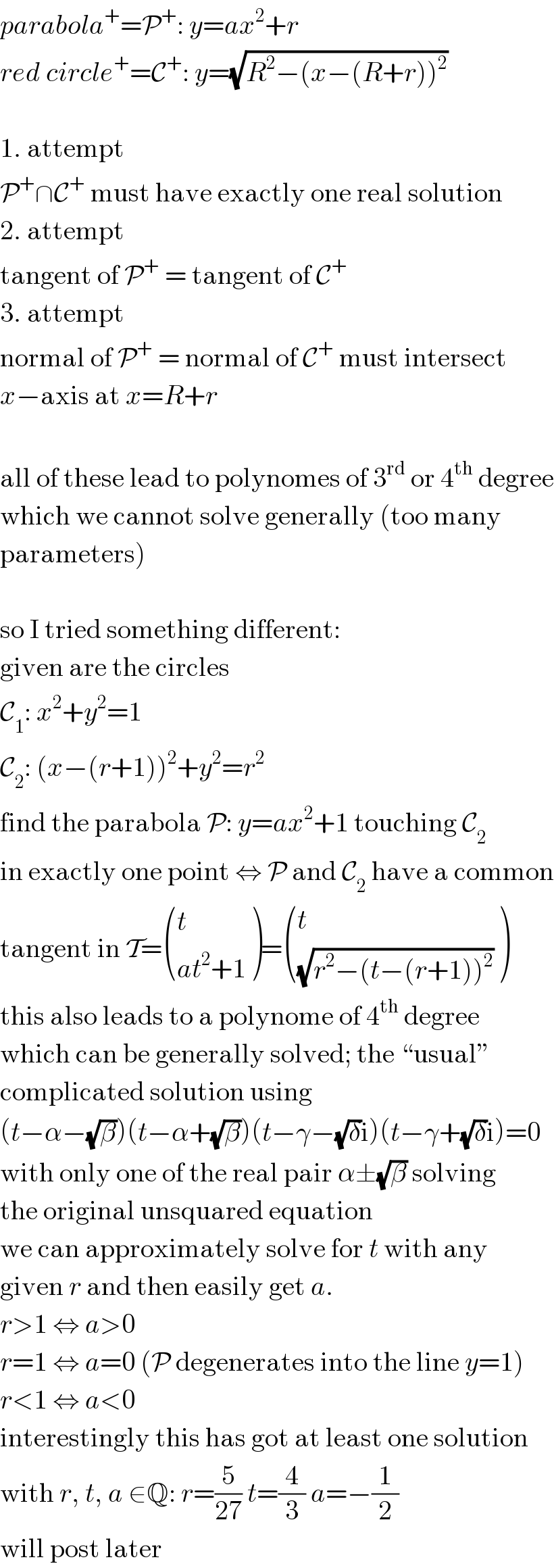Question Number 42624 by ajfour last updated on 29/Aug/18

Commented by ajfour last updated on 29/Aug/18

$${The}\:{smaller}\:{circle}\:{has}\:{radius}\:\boldsymbol{{r}}. \\ $$$${The}\:{two}\:{parabolas}\:{are}\:{reflection} \\ $$$${of}\:{one}\:{another}\:{in}\:{x}-{axis}. \\ $$$${Equation}\:{of}\:{upper}\:{parabola}\:{is} \\ $$$$\:{y}={ax}^{\mathrm{2}} +{r}\:.\:{Find}\:{radius}\:\boldsymbol{{R}}\:{of}\: \\ $$$${larger}\:{circle}\:{in}\:{terms}\:{of}\:\boldsymbol{{a}},\:\boldsymbol{{r}}\:. \\ $$
Commented by MJS last updated on 02/Sep/18

$${parabola}^{+} =\mathcal{P}^{+} :\:{y}={ax}^{\mathrm{2}} +{r} \\ $$$${red}\:{circle}^{+} =\mathcal{C}^{+} :\:{y}=\sqrt{{R}^{\mathrm{2}} −\left({x}−\left({R}+{r}\right)\right)^{\mathrm{2}} } \\ $$$$ \\ $$$$\mathrm{1}.\:\mathrm{attempt} \\ $$$$\mathcal{P}^{+} \cap\mathcal{C}^{+} \:\mathrm{must}\:\mathrm{have}\:\mathrm{exactly}\:\mathrm{one}\:\mathrm{real}\:\mathrm{solution} \\ $$$$\mathrm{2}.\:\mathrm{attempt} \\ $$$$\mathrm{tangent}\:\mathrm{of}\:\mathcal{P}^{+} \:=\:\mathrm{tangent}\:\mathrm{of}\:\mathcal{C}^{+} \\ $$$$\mathrm{3}.\:\mathrm{attempt} \\ $$$$\mathrm{normal}\:\mathrm{of}\:\mathcal{P}^{+} \:=\:\mathrm{normal}\:\mathrm{of}\:\mathcal{C}^{+} \:\mathrm{must}\:\mathrm{intersect} \\ $$$${x}−\mathrm{axis}\:\mathrm{at}\:{x}={R}+{r} \\ $$$$ \\ $$$$\mathrm{all}\:\mathrm{of}\:\mathrm{these}\:\mathrm{lead}\:\mathrm{to}\:\mathrm{polynomes}\:\mathrm{of}\:\mathrm{3}^{\mathrm{rd}} \:\mathrm{or}\:\mathrm{4}^{\mathrm{th}} \:\mathrm{degree} \\ $$$$\mathrm{which}\:\mathrm{we}\:\mathrm{cannot}\:\mathrm{solve}\:\mathrm{generally}\:\left(\mathrm{too}\:\mathrm{many}\right. \\ $$$$\left.\mathrm{parameters}\right) \\ $$$$ \\ $$$$\mathrm{so}\:\mathrm{I}\:\mathrm{tried}\:\mathrm{something}\:\mathrm{different}: \\ $$$$\mathrm{given}\:\mathrm{are}\:\mathrm{the}\:\mathrm{circles} \\ $$$$\mathcal{C}_{\mathrm{1}} :\:{x}^{\mathrm{2}} +{y}^{\mathrm{2}} =\mathrm{1} \\ $$$$\mathcal{C}_{\mathrm{2}} :\:\left({x}−\left({r}+\mathrm{1}\right)\right)^{\mathrm{2}} +{y}^{\mathrm{2}} ={r}^{\mathrm{2}} \\ $$$$\mathrm{find}\:\mathrm{the}\:\mathrm{parabola}\:\mathcal{P}:\:{y}={ax}^{\mathrm{2}} +\mathrm{1}\:\mathrm{touching}\:\mathcal{C}_{\mathrm{2}} \\ $$$$\mathrm{in}\:\mathrm{exactly}\:\mathrm{one}\:\mathrm{point}\:\Leftrightarrow\:\mathcal{P}\:\mathrm{and}\:\mathcal{C}_{\mathrm{2}} \:\mathrm{have}\:\mathrm{a}\:\mathrm{common} \\ $$$$\mathrm{tangent}\:\mathrm{in}\:\mathcal{T}=\begin{pmatrix}{{t}}\\{{at}^{\mathrm{2}} +\mathrm{1}}\end{pmatrix}=\begin{pmatrix}{{t}}\\{\sqrt{{r}^{\mathrm{2}} −\left({t}−\left({r}+\mathrm{1}\right)\right)^{\mathrm{2}} }}\end{pmatrix} \\ $$$$\mathrm{this}\:\mathrm{also}\:\mathrm{leads}\:\mathrm{to}\:\mathrm{a}\:\mathrm{polynome}\:\mathrm{of}\:\mathrm{4}^{\mathrm{th}} \:\mathrm{degree} \\ $$$$\mathrm{which}\:\mathrm{can}\:\mathrm{be}\:\mathrm{generally}\:\mathrm{solved};\:\mathrm{the}\:“\mathrm{usual}'' \\ $$$$\mathrm{complicated}\:\mathrm{solution}\:\mathrm{using} \\ $$$$\left({t}−\alpha−\sqrt{\beta}\right)\left({t}−\alpha+\sqrt{\beta}\right)\left({t}−\gamma−\sqrt{\delta}\mathrm{i}\right)\left({t}−\gamma+\sqrt{\delta}\mathrm{i}\right)=\mathrm{0} \\ $$$$\mathrm{with}\:\mathrm{only}\:\mathrm{one}\:\mathrm{of}\:\mathrm{the}\:\mathrm{real}\:\mathrm{pair}\:\alpha\pm\sqrt{\beta}\:\mathrm{solving} \\ $$$$\mathrm{the}\:\mathrm{original}\:\mathrm{unsquared}\:\mathrm{equation} \\ $$$$\mathrm{we}\:\mathrm{can}\:\mathrm{approximately}\:\mathrm{solve}\:\mathrm{for}\:{t}\:\mathrm{with}\:\mathrm{any} \\ $$$$\mathrm{given}\:{r}\:\mathrm{and}\:\mathrm{then}\:\mathrm{easily}\:\mathrm{get}\:{a}. \\ $$$${r}>\mathrm{1}\:\Leftrightarrow\:{a}>\mathrm{0} \\ $$$${r}=\mathrm{1}\:\Leftrightarrow\:{a}=\mathrm{0}\:\left(\mathcal{P}\:\mathrm{degenerates}\:\mathrm{into}\:\mathrm{the}\:\mathrm{line}\:{y}=\mathrm{1}\right) \\ $$$${r}<\mathrm{1}\:\Leftrightarrow\:{a}<\mathrm{0} \\ $$$$\mathrm{interestingly}\:\mathrm{this}\:\mathrm{has}\:\mathrm{got}\:\mathrm{at}\:\mathrm{least}\:\mathrm{one}\:\mathrm{solution} \\ $$$$\mathrm{with}\:{r},\:{t},\:{a}\:\in\mathbb{Q}:\:{r}=\frac{\mathrm{5}}{\mathrm{27}}\:{t}=\frac{\mathrm{4}}{\mathrm{3}}\:{a}=−\frac{\mathrm{1}}{\mathrm{2}} \\ $$$$\mathrm{will}\:\mathrm{post}\:\mathrm{later} \\ $$
Answered by ajfour last updated on 03/Sep/18
![eq. of parabola y = ax^2 +r P(x_1 , y_1 ) eq. of larger circle (R+r−x)^2 +y^2 = R^2 distance of P from centre of larger circle is R ⇒ R^2 =(R+r−x)^2 +(ax^2 +r)^2 2R((dR/dx))=2(R+r−x)((dR/dx)−1)+ 2(ax^2 +r)(2ax) As R is minimum, (dR/dx) must be zero: ⇒ R+r−x = 2ax(ax^2 +r) ⇒ x = f(R) ⇒ R^2 =[R+r−f(R)]^2 +{a[f(R)]^2 +r}^2 R is then obtained from above eq. ________________________](https://www.tinkutara.com/question/Q42651.png)
$${eq}.\:{of}\:{parabola}\:\:\:\:\:\:{y}\:=\:{ax}^{\mathrm{2}} +{r} \\ $$$$\:{P}\left({x}_{\mathrm{1}} ,\:{y}_{\mathrm{1}} \right) \\ $$$${eq}.\:{of}\:{larger}\:{circle} \\ $$$$\left({R}+{r}−{x}\right)^{\mathrm{2}} +{y}^{\mathrm{2}} =\:{R}^{\mathrm{2}} \\ $$$${distance}\:{of}\:{P}\:{from}\:{centre}\:{of} \\ $$$${larger}\:{circle}\:{is}\:{R} \\ $$$$\Rightarrow\:{R}^{\mathrm{2}} =\left({R}+{r}−{x}\right)^{\mathrm{2}} +\left({ax}^{\mathrm{2}} +{r}\right)^{\mathrm{2}} \\ $$$$\mathrm{2}{R}\left(\frac{{dR}}{{dx}}\right)=\mathrm{2}\left({R}+{r}−{x}\right)\left(\frac{{dR}}{{dx}}−\mathrm{1}\right)+ \\ $$$$\:\:\:\:\:\:\:\:\:\:\:\:\:\:\:\:\:\:\:\:\:\:\:\:\:\:\:\:\:\:\mathrm{2}\left({ax}^{\mathrm{2}} +{r}\right)\left(\mathrm{2}{ax}\right) \\ $$$${As}\:{R}\:{is}\:{minimum},\:\:\frac{{dR}}{{dx}}\:{must}\:{be}\:{zero}: \\ $$$$\Rightarrow\:{R}+{r}−{x}\:=\:\mathrm{2}{ax}\left({ax}^{\mathrm{2}} +{r}\right) \\ $$$$\Rightarrow\:\:{x}\:=\:{f}\left({R}\right) \\ $$$$\Rightarrow\:\:{R}^{\mathrm{2}} =\left[{R}+{r}−{f}\left({R}\right)\right]^{\mathrm{2}} +\left\{{a}\left[{f}\left({R}\right)\right]^{\mathrm{2}} +{r}\right\}^{\mathrm{2}} \\ $$$${R}\:{is}\:{then}\:{obtained}\:{from}\:{above}\:{eq}. \\ $$$$\_\_\_\_\_\_\_\_\_\_\_\_\_\_\_\_\_\_\_\_\_\_\_\_ \\ $$
